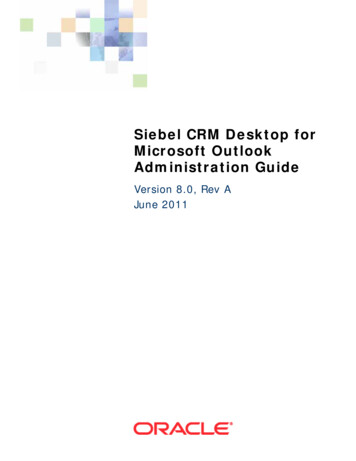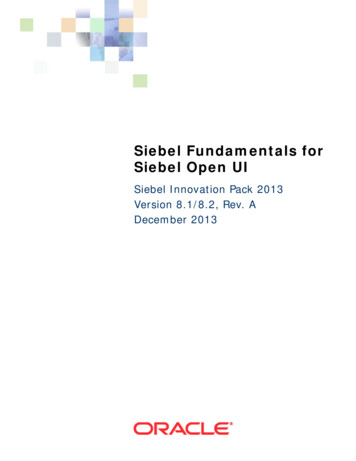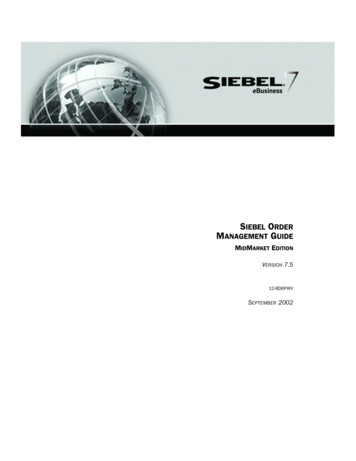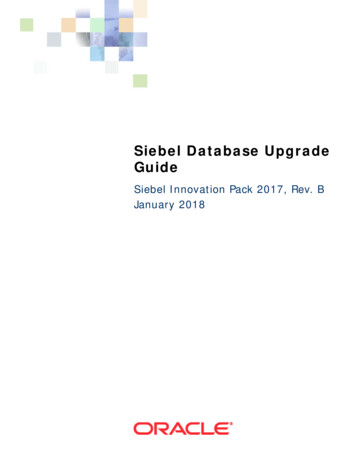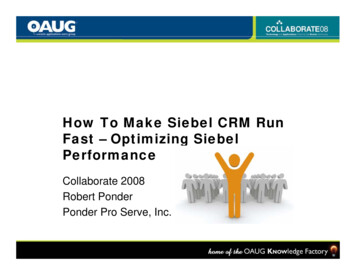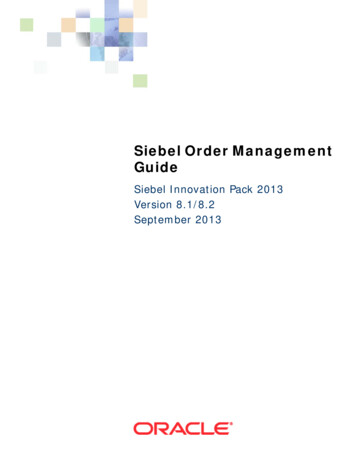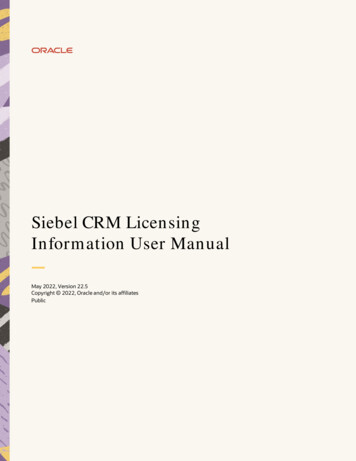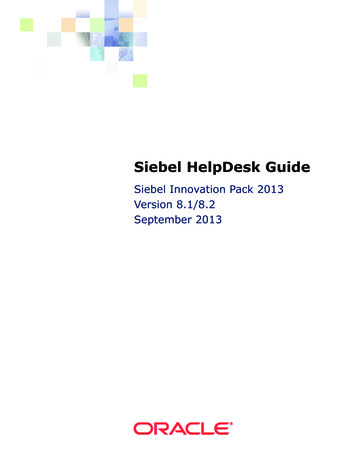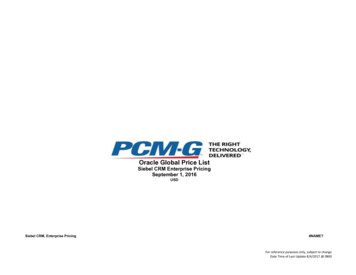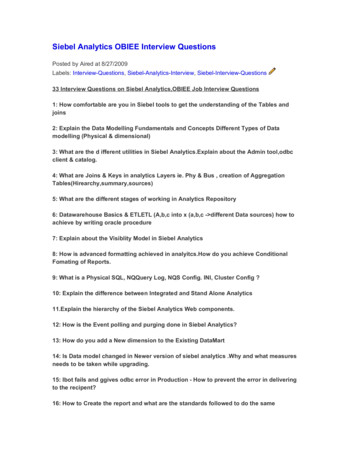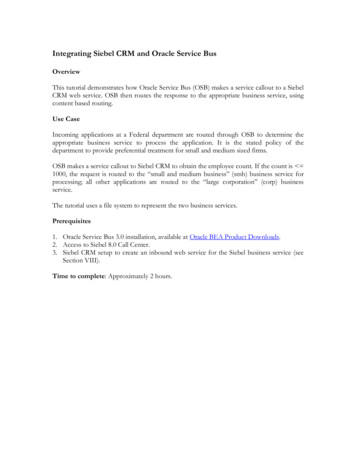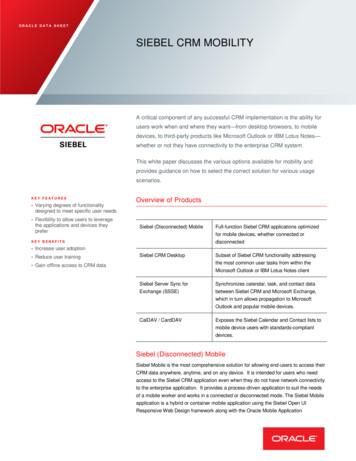
Transcription
ORACLE DAT A SHEETSIEBEL CRM MOBILITYA critical component of any successful CRM implementation is the ability forusers work when and where they want—from desktop browsers, to mobiledevices, to third-party products like Microsoft Outlook or IBM Lotus Notes—whether or not they have connectivity to the enterprise CRM system.This white paper discusses the various options available for mobility andprovides guidance on how to select the correct solution for various usagescenarios.KEY FEATURES Varying degrees of functionalitydesigned to meet specific user needs Flexibility to allow users to leveragethe applications and devices theypreferOverview of ProductsSiebel (Disconnected) Mobilefor mobile devices, whether connected ordisconnectedKEY BENEFITS Increase user adoption Reduce user training Gain offline access to CRM dataFull-function Siebel CRM applications optimizedSiebel CRM DesktopSubset of Siebel CRM functionality addressingthe most common user tasks from within theMicrosoft Outlook or IBM Lotus Notes clientSiebel Server Sync forSynchronizes calendar, task, and contact dataExchange (SSSE)between Siebel CRM and Microsoft Exchange,which in turn allows propagation to MicrosoftOutlook and popular mobile devices.CalDAV / CardDAVExposes the Siebel Calendar and Contact lists tomobile device users with standards-compliantdevices.Siebel (Disconnected) MobileSiebel Mobile is the most comprehensive solution for allowing end-users to access theirCRM data anywhere, anytime, and on any device. It is intended for users who needaccess to the Siebel CRM application even when they do not have network connectivityto the enterprise application. It provides a process-driven application to suit the needsof a mobile worker and works in a connected or disconnected mode. The Siebel Mobileapplication is a hybrid or container mobile application using the Siebel Open UIResponsive Web Design framework along with the Oracle Mobile Application
ORACLE DAT A SHEETFramework to provide access to native features of mobile devices. The Siebel Mobileapplication can be downloaded from Apple Apps store or Google Play depending on theplatform. Oracle also provides the mobile project archive file which allows customers touse their own profile and publish it to their custom apps store, thereby giving bettercontrol on the deployment.Figure 1: Siebel CRM Mobile applicationTypical Use Cases for Siebel (Disconnected) MobileWe provide a number of Siebel Mobile Applications which are configured fordisconnected use out-of-the-box, including Pharma Mobile, Field Service Mobile, andSales Mobile.Field Service Mobile and Sales Mobile can be used across multiple Industries coveringsales or field service use cases. Customers need to download only one application(Siebel Mobile) from the Apps Store or Google play but depending on the backendconfiguration of the Siebel Server can use Field Service, Sales, or Pharma Mobile. Life Sciences: Pharmaceutical sales representatives armed with tablets whovisit health care providers and wish to present multi-media product informationand capture sample drops, even when they have no network connectivity. Field Services: Technicians who need to be able to select their next activity;get directions to customer sites; have access to customer, product, and assetinformation; and capture parts used, time, and expenses. Sales: Sales representatives who spend most of their time on the roadmeeting customers, who capture customer information before and after themeeting, allowing them to follow their leads and opportunities.2 SIEBEL CRM MOBILITY
ORACLE DAT A SHEETSiebel CRM DesktopSiebel CRM Desktop is designed for those users who rely on the popular MicrosoftOutlook and IBM Lotus Notes applications for managing their customer interactions, butneed to ensure that their customer data and interactions are captured in the CRMapplication.Beyond simply synchronizing basic calendar, task, and contact data, Siebel CRMDesktop exposes CRM data and functionality directly within the host client.Examples include (but are not limited to): When working with a calendar item, the user can associate it to a CRMaccount or opportunity as an activity, allowing sales team members andmanagement to see customer touch points in the context of sales activity. When creating a calendar item, any invitee will automatically be added to thecontact or employee list for the related CRM activity. Users may relate an inbound or outbound email to a particular customeraccount, sales opportunity, or any other syncing object. The user can also setup automatic associations of all inbound and outbound email for a givencontact or customer account.Siebel CRM Desktop provides CRM business logic, including availability of custom fieldsand enforcement of validation rules (required fields, pick lists, calculated fields, etc.)within the host application. Providing validation at the time of data entry ensures thatusers are notified immediately of any validation issues, which helps ensure they canaddress them quickly.Figure 2: Maintain CRM Data in Microsoft OutlookAll functions available in Siebel CRM Desktop are available to users regardless ofwhether they are online or offline. Any changes made in their desktop productivityapplication are maintained regardless of whether there is immediate access to the CRMapplication. When users reconnect, any data updated on the client are uploaded to theserver and vice versa. Any conflicts are reported to the user, who can determine theappropriate resolution.3 SIEBEL CRM MOBILITY
ORACLE DAT A SHEETSince users are already familiar with navigation, search, data entry, and other featuresof their desktop productivity application, organizations can allocate valuable training timeon topics vital to the success of the CRM implementation, such as how individualopportunity status information feeds overall sales pipeline forecast through the backoffice to support and manufacturing.It should be noted that Siebel CRM Desktop is intended to provide users with access tothe CRM functionality they need every day, and is not intended to replace the entireCRM application. For example, a sales representative might need to update customeraccount and sales opportunity information on a daily basis and could do so withinOutlook or Lotus notes using the CRM Desktop add-in, but for less frequent tasks—such as updating end-of-month forecasts or generating quotes or proposals—the userwould return to the full Siebel CRM web-based client.Typical Use Cases for Siebel CRM Desktop Sales representatives who currently manage their contacts, calendar, andtasks within Outlook or Notes and need basic access to view and makechanges to a subset of their CRM data. Field service technicians who need to be able to have access to customer,product, and asset information, capture parts used, time, and expenses.Siebel Server Sync for Exchange (SSSE)Siebel Server Sync for Exchange provides server-side integration between Siebel CRMand Microsoft Exchange for objects native to both applications—calendar, contact, andtask. It is a lightweight solution, requiring no client-side installation or action by the enduser and no installation requirement on the Exchange server.SSSE overcomes the challenge of making the CRM system transparent to front-linesales, service, and marketing employees. Keeping the CRM system up-to-datebecomes part of a user’s daily tasks and can be done within Microsoft Outlook.This extensive integration includes: A server-based synchronization engine that synchronizes calendar, contacts, andtasks between Siebel applications and Microsoft Exchange Server—this is done inthe background without requiring active user intervention A Microsoft Outlook add-in that allows users to link Microsoft Outlook contacts, tasks,and appointments to Siebel data such as opportunities and service requests—speeding and simplifying the process of tracking every customer interaction Siebel Server Sync for Microsoft Exchange Server extends the benefits of desktopproductivity applications into a value-added activity that improves the customerexperience and drives user adoption of CRM systems.Siebel Server Sync for Microsoft Exchange Server enables near-real-time, bidirectionalsynchronization of calendar appointments, contacts, and task items between the CRMdatabase and Microsoft Exchange Servers. This occurs in the background—eliminatingthe need for employees to remember special steps for synchronizing the applications.Users can schedule appointments through Siebel applications, and the meetings arevisible in all participants’ Microsoft Exchange calendars and vice versa. When userspropose or change meetings, these actions are automatically reflected in the Siebelapplication.4 SIEBEL CRM MOBILITY
ORACLE DAT A SHEETSiebel server-based synchronization drives user adoption, as users can continue to usethe productivity tools they already use while maintaining current data in the Siebel CRMsystem. Whether the user maintains a calendar or contact data in Microsoft Outlook,Outlook Web Access, or even on a third-party mobile device that is already sharing datawith Microsoft Exchange, data is shared with the CRM application. The seamlessintegration between Siebel CRM applications and Microsoft Outlook will significantlylower training costs and increase user adoption.The engine also supports a lower total cost of ownership driven by consolidatingfunctionality into server components, centralizing administration, and eliminating clientbased configuration. The seamless integration reduces maintenance overhead andimproves operational efficiency.All components run only on the Microsoft Windows platform. Administrators do not needto install any components on their Microsoft Exchange Servers. The Siebel serverbased synchronization engine supports Microsoft Exchange 2010 and later usingExchange Web Services.Siebel Server Sync for Microsoft Exchange Server comes with an optional add-in thatallows users to use Microsoft Outlook to link calendar appointments, contacts, and taskitems to Siebel applications. For example, users can create calendar appointments inMicrosoft Outlook and link those appointments to the relevant opportunity that they havecreated in the Siebel Sales application without leaving Outlook. Once users associateSiebel links with a Microsoft Outlook record, they can use these links to navigate directlyfrom the Microsoft Outlook client into the appropriate Siebel application.Typical Use Cases for Siebel Server Sync for Exchange (SSSE) Sales or service representatives who currently manage their contacts,calendar, and tasks within Outlook or their mobile device and need only rareaccess to other CRM data. Users need near-real time, transparent server-side synchronization of databetween Exchange and Siebel CRM.CalDAV / CardDAV IntegrationCalDAV and CardDAV are industry standards allowing calendar and contact data(respectively) from a host server (in this case Siebel) to be presented to users forviewing on modification on a compliant client. For example, a user of an Apple iPhonedevice could subscribe to the Siebel Calendar and see appointments from the CRMapplication overlaid with other (such as their corporate or personal) calendars on thesame device. Similarly, a user’s Siebel contacts can appear as an additional addressbook on the mobile device.It is important to understand that CalDAV/CardDAV integration introduces an additionalcalendar/address book on the client device, and as such does not providesynchronization between existing calendars and address books. For example, assumethat a user were invited to a meeting by a customer and that invitation were to bereceived via the user’s corporate Exchange server and the user accepted via theOutlook client. That meeting would be visible to the user on his or her mobile devicecalendar, but it would be on their corporate calendar, not their Siebel Calendar—themeeting would not be visible within the CRM application itself.5 SIEBEL CRM MOBILITY
ORACLE DAT A SHEETTypical Use Cases for CalDAV / CardDAV Service users whose primary calendar is the Siebel Calendar and need to beable to see appointments on mobile devices Users who want to easy access to their CRM contacts on their mobile devices.CONTACT USFor more information about Siebel CRM, visit oracle.com or call 1.800.ORACLE1 to speak to an Oraclerepresentative.CONNECT W ITH crmtwitter.com/oraclecrmCopyright 2016, Oracle and/or its affiliates. All rights reserved. This document is provided for information purposes only, and thecontents hereof are subject to change without notice. This document is not warranted to be error-free, nor subject to any otherwarranties or conditions, whether expressed orally or implied in law, including implied warranties and conditions of merchantability orfitness for a particular purpose. We specifically disclaim any liability with respect to this document, and no contractual obligations areformed either directly or indirectly by this document. This document may not be reproduced or transmitted in any form or by anymeans, electronic or mechanical, for any purpose, without our prior written permission.Oracle and Java are registered trademarks of Oracle and/or its affiliates. Other names may be trademarks of their respective owners.oracle.com/siebel6 SIEBEL CRM MOBILITYIntel and Intel Xeon are trademarks or registered trademarks of Intel Corporation. All SPARC trademarks are used under license andare trademarks or registered trademarks of SPARC International, Inc. AMD, Opteron, the AMD logo, and the AMD Opteron logo aretrademarks or registered trademarks of Advanced Micro Devices. UNIX is a registered trademark of The Open Group. 1116
Siebel CRM Desktop is designed for those users who rely on the popular Microsoft Outlook and IBM Lotus Notes applications for managing their customer interactions, but need to ensure that their customer data and interactions are captured in the CRM application. Beyond simply synchronizing basic calendar, task, and contact data, Siebel CRM
